See the history of Dubai hiding in plain sight in old Dubai. Bastakiya, also called Al Fahidi Historical Neighborhood, is a preserved quarter of old houses standings as the last remaining specimens of Dubai’s bygone days. Today, they are full of miniature museums, art galleries, cafes, and guest houses that tell stories from history and cultural heritage. Al Bastakiya is part of the Dubai city tour.
History of Al Bastakiya
Bastakiya is located in Bur Dubai, a predominantly residential district since the rise of Dubai. During the late 19th century, after a plague decimated much of the city’s population, Deira became the leading marketplace, and Bur Dubai was where they built their houses. There developed a few yet smaller souks in the area nonetheless.
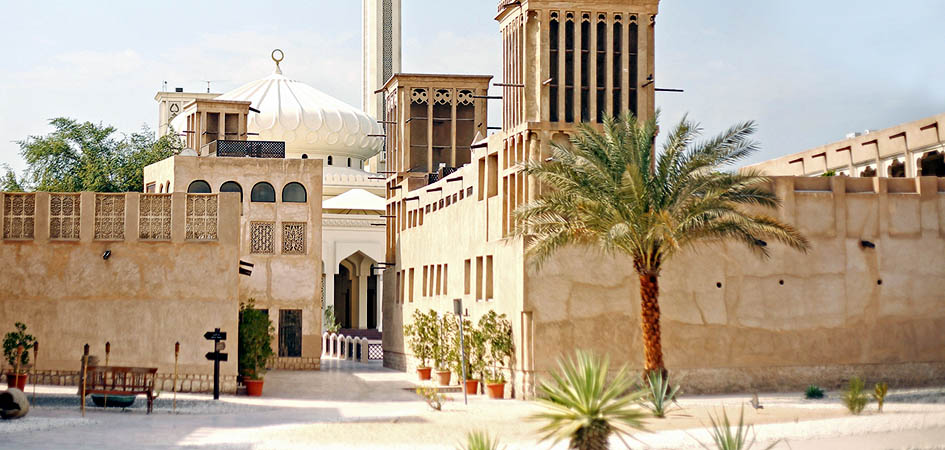
When was Al Bastakiya built?
The buildings in Bastakiya are over a century old. It is believed to have been built around 1890 by Sunni Iranian merchants who settled in Dubai, running away from persecution in their homeland. They were initially from Bastak in Iran, which later became the quarter’s name where they lived.
The Bastakiya comprised 60 houses separated by narrow and winding lanes during its prime days. After the 1950s, after the newfound economic growth of Dubai, immigrant workers from India, Pakistan, and Bangladesh inhabited these houses. Some of them even became warehouses. But after a few decades, the government of Dubai decided to protect them as a mark of its heritage. They were restored to their former shapes in the early 2000s before opening them for visitors.
Some decades ago, a larger cluster of buildings extended from where the Dubai museum is today to the present-day entrance of the Bastakiya. Some sets were demolished during the 1980s to build office buildings today. That was before tourism became a thing in Dubai. Nobody was interested in preserving many dilapidated houses on the verge of collapsing.
Wind towers over the buildings were the mark of the rich men’s houses in those days. These towers helped cool the homes’ interiors in hot weather like modern-day air conditioners. But these were relatively expensive to build, and those who could not afford them built Arish houses to cope with the summer heat.
Another distinctive mark of these houses is the dark brown wooden doors braced with bronze handles.
Things To Do In Al Bastakiya Dubai
XVA Gallery
The XVA Gallery showcases the work of Arab artists. This is an art gallery, a cafe, and a hotel, all simultaneously. The restaurant serves vegetarian dishes of middle eastern heritage, although that is a rarity. The rooms in the hotel provide a beautiful view of the courtyard. So if you want to stay in the same buildings the local Arabs did a century ago in royal style, XVA is the place to go.
Majlis Gallery
The building housing the majlis gallery was the house of Mira Abdulla Amiri. Established in the 1960s, it was the first-ever art gallery in Dubai. Before becoming an art gallery, it was a guest house to host essential guests from neighboring regions like Oman and Bahrain. Instead of using the walls to hang the artworks, the walls of the majlis gallery itself are canvases. They have the contributions of a variety of artists over many decades.
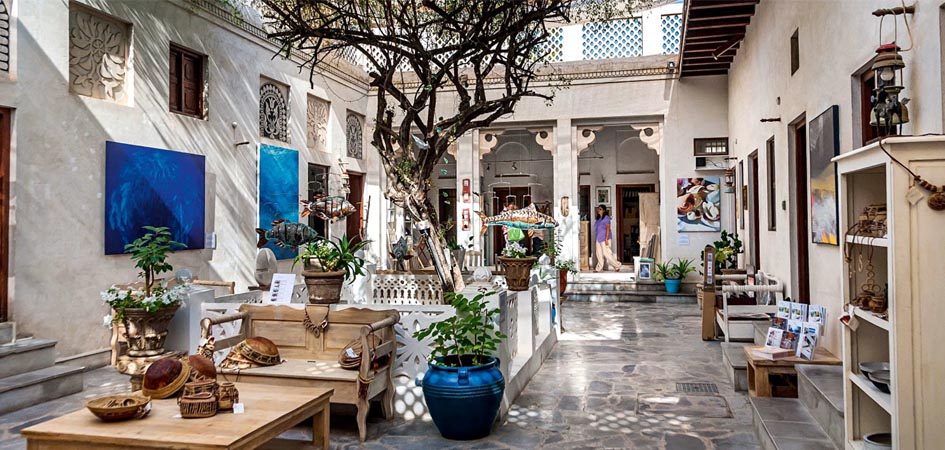
Sahara Gate
It is a beautiful building with walls adorned with Arabic calligraphy. Built in 1954 by Sheikh Habib al Haji, this is a prime example of the traditional Arabic architecture in Bastakiya. The original owner handed this to Dubai’s Culture and Tourism department in 2005.
Dar Al Nadwa
This two-story building functions as the main auditorium in Bastakiya. There will be something happening here every day during the winter months.
Architectural Heritage Society
A centerpiece that shows the elegance of old Arabic architecture in Bastakiya. It was established in 2003 and preserved and documented the urban heritage in the UAE. The building dates back to 1936 and contains various elements of traditional architecture. Since its renovation and reopening in 2003, it has also doubled as the headquarters of the Urban heritage society.
Sheikh Muhammad Center for Cultural Understanding
This is an initiative by the government of Dubai to build understanding and tolerance between different cultures. The center will provide visitors with traditional clothes and the cuisine of the UAE. Try those garments, and enjoy the traditional dishes. This one is not free, though. You have to either book through their official website or book with a tour provider to participate in the cultural programs by SMCCU.
They offer different packages depending on the day you want to visit. You can choose between a cultural breakfast, brunch, lunch, and evening tea. This is a great way to experience the traditional aspects of Dubai, along with traditional tastes.
Restaurants in Al Bastakiya
Arabian Tea House
Even though coffee has been the most popular recreational drink in the Arab world, tea also exists. The Arabian Tea House offers 50 varieties of teas and traditional Emirati cuisine. This restaurant has its entrance on Al Fahidi street and is easily accessible.
Bastakiya Nights
This restaurant is in the oldest building in Bastakiya. You will know you are somewhere around this restaurant when you smell the aroma of hot kebabs. Unlike the cafe in XVA, which specializes in vegetarian dishes, kebabs are the signature items here.
The restaurant has an open-air courtyard in the center of the building, a refreshing place to enjoy food. This used to be a mansion with a lavish design and is more significant than other buildings in Bastakiya.
Hotels in Al Bastakiya
XVA Gallery
The hotel also has an artsy side to it.
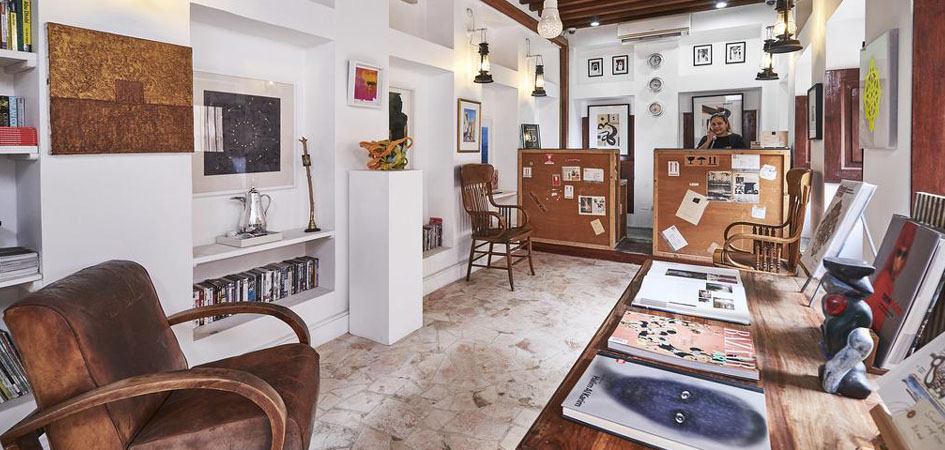
Orient Guest House
This traditional Arab villa was repurposed into a high-end business hotel in Bastakiya. The two-story buildings had been restored to their former glory along with others.
Best time to visit Al Bastakiya
The timing of Bastakiya is from morning 9 am to evening 6 pm. The best time to visit it is during the afternoons during the winter months. This is also a quiet place right next to the creek and
Do you need to book in advance to visit Bastakiya?
No, you don’t have to book in advance if you only want to see around Bastakiya and visit the art galleries and museums. But the Sheikh Muhammad Centre for Cultural Understanding requires you to book beforehand to participate in their cultural dining programs. You also have to pay a fee depending on the package and the number of people.
Entrance Fee
Entry to Bastakiya is free. You can walk around and explore the alleys free of cost. Many of the attractions in Bastakiya are also free, as well. These include the coin museum, XVA Gallery,
Location of Bastakiya
Bastakiya is on the Bur Dubai side of the creek on Al Fahidi Road. The entrance of Al Bastakiya is right next to the Al Fahidi roundabout, where Al Fahidi road and Al Hamriya Street meet. The old-looking buildings of Bastakiya contrast with the modern concrete structures and are hard to miss.
Another advantage is that the location is well connected by public transport. Less than a kilometer away is the Ghubaiba bus station and the Al Fahidi metro station is about five minutes on foot. Or, if you don’t want to switch between the red and green metro lines, you can walk five more minutes to the Burjuman metro station.
Other attractions near Bastakiya
Being in the heart of old Dubai, there are plenty of attractions near Bastakiya.
On Bur Dubai Side:
Dubai museum
The Dubi Museum is the oldest and most comprehensive museum in Dubai, located in the Al Fahidi fort.
Al Seef
Al Seef is just opposite the main entrance of Bastakiya. Al Seef is a modern mall that follows the traditional architecture similar to Bastakiya.
Textile Souk
The textile Souk is a remanence of the marketplace in Dubai during the early 20th century.
Shindagha Museum
The Shindagha Museum is one of the best museums in Dubai and is within walking distance of Al Bastakiya.
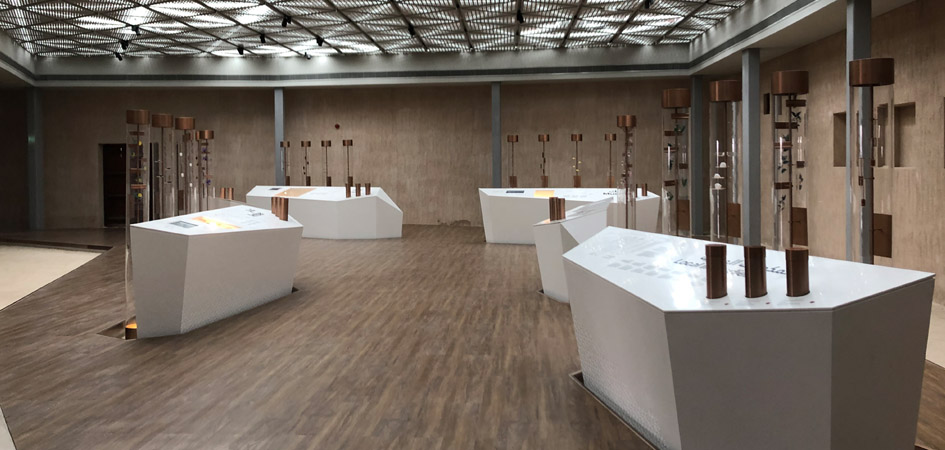
House of Sheikh Saeed bin Maktoum – The palace of the ruler of Dubai between 1912 and 1958. Today it functions as a museum displaying the household items used by royalty. It also has old photographs and artifacts.
Dubai dolphinarium – watch the performances by dolphins and colorful birds
Abra – take an abra ride to Deira.
On Deira Side:
Gold souk – the oldest and busiest gold market in Dubai. Also one of the best places to buy gold.
The Naif Museum is a part of the naif police station, the first in Dubai. The naif museum curates the history and development of the police force in Dubai.
Spice souk – See the colorful varieties of spices in the old market area of Dubai.
Sikka Art Fair Dubai
Bastakiya becomes host to one of the country’s most significant cultural and art festivals every year. Leading artists from the UAE and the world share their love for the craft here. Art exhibits, movie screenings, poetry competitions, and more are part of the Sikka Art Fair in Dubai’s heritage center.
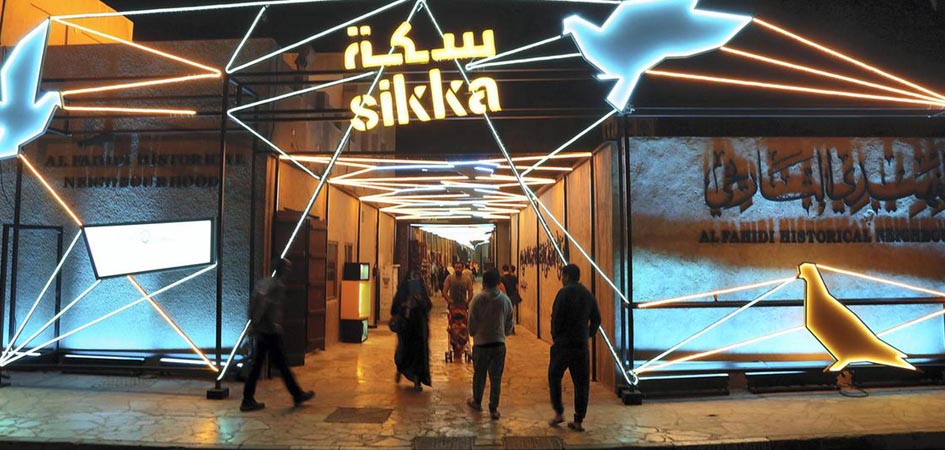
Sikka is an excellent place for aspiring artists to interact with established artists and attend workshops. There happened to be sixty workshops in 2019 alone. That’s more than enough to satiate the creative side of anyone.
Bastakiya will be lit up and decorated with colorful banners during the festival season. This historical place has become a center of eclectic modern art. The festival lasts for a full ten days. Sikka is held under the patronage of Her Highness Sheikha Latifa bint Muhammad bin Rashid Al Maktoum. So plan your Bastakiya visit to coincide with Sikka Arts Fair if you are an art enthusiast.
Sikka festival dates for 2022 are from March 19, 2020, to 29, 2022.

